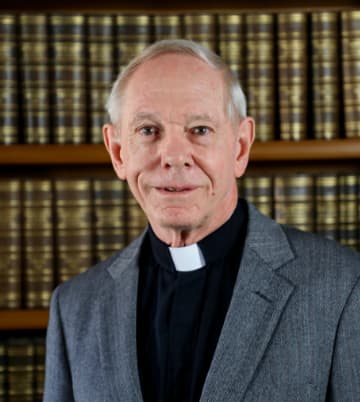Rev. Christopher J. Corbally, S.J.

Rev. Christopher J. Corbally, S.J.
Education:
- Lic.Phil. Philosophy – Heythrop College, Oxfordshire – 1968
- B.S. Physics – Bristol University – 1971
- M.S. Astronomy – University of Sussex, Brighton – 1972
- B.D. Theology – Heythrop College, London – 1976
- Pastoral Diploma – Heythrop College, London – 1977
- Ph.D. Astronomy – Univ. of Toronto (Canada) - 1983
Memberships:
- Royal Astronomical Society
- American Astronomical Society
- International Astronomical Union
- 2009-2012 - President of Division IV (stars)
- Institute on Religion in an Age of Science
- 1999-2002 - President
Fr. Chris Corbally S.J. was born near London in 1946 and entered the Society of Jesus in 1963. He completed the licentiate in philosophy at Heythrop College, Oxfordshire in 1968; his B.S. in physics at Bristol University in 1971; and his M.S. in astronomy at the University of Sussex (Brighton) in 1972. He was ordained in 1976, the year that he earned a B.D. in theology from Heythrop College, London, where he also gained a Pastoral Diploma in 1977.
After ordination, he obtained a PhD in astronomy at the University of Toronto (Canada) in 1983. Since then Fr. Corbally has been a research astronomer of the Vatican Observatory and was its Vice Director for the Vatican Observatory Research Group in Tucson until 2012.
He is a member of the Royal Astronomical Society, the American Astronomical Society, the President of the National Committee for Astronomy in the Vatican City State for the International Astronomical Union. He was the president of the IAU's Division IV (Stars), 2009-2012. He is a member of the Institute on Religion in an Age of Science, for which he was president from 1999-2002.
Research Interests:
Fr. Corbally’s research interests include multiple star systems, stellar spectral classification, peculiar and metal-weak stars especially those with lambda Boötis characteristics, activity in solar-type stars, galactic structure and star formation regions, and telescope technology. He has had a long-term interest in interdisciplinary questions and is currently studying the characteristics of human sentience in the context of evolution.
Books:
- Corbally, C.J., Gray, R.O., And Garrison, R.F. 1994, (Eds.) The MK Process at 50 Years: A Powerful Tool for Astrophysical Insight, Astronomical Society of the Pacific Conference Series (San Francisco), Vol. 60.
- Gray, R. O., Corbally, C. J., Philip, A. G. D. 2003, (Eds.) The Garrison Festschrift (Schenectady: L. Davis Press)
- Corbally, C., Bailer-Jones, C., Giridhar, S., and Lloyd Evans, T. 2006, (Eds.) Exploiting Large Surveys for Galactic Astronomy, the Proceedings of the Joint Discussion 13 at the IAU General Assembly XXVI, Mem.S.A.It., 77, 1026-1190 (and its online version)
- Gray, R. O., Corbally, C. J. 2009, Stellar Spectral Classification, Princeton Series in Astrophysics (Princeton, NJ: Princeton University Press), xvi + 592 pp
Recent Peer-Reviewed Publications:
- CORBALLY, C.J., Straižys, V. 2009, Young Stars in the Camelopardalis Dust and Molecular Clouds. V. More YSOs Confirmed Spectroscopically, Baltic Astronomy, 18, 1-18
- CORBALLY, C.J., Straižys, V., Laugalys, V. 2009, Spectral Analysis of YSOs and Other Emission-Line Stars in the North America and Pelican Nebulae Region, Baltic Astronomy, 18, 111-139
- Gray, R. O., McGahee, C. E., Griffin, R. E. M., CORBALLY, C. J. 2011, First Direct Evidence That Barium Dwarfs Have White Dwarf Companions, Astron.J. 141, 160.
- Griffin, R.E., Gray, R.O., CORBALLY, C.J., 2012. The composite-spectrum binary hypothesis does not explain the lambda Boötis stars. A&A, 547, A8, 1-14.
- Gray, R.O., and CORBALLY, C.J. 2014, An Expert Computer Program for Classifying Stars on the MK Spectral Classification System, Astron.J. 147, 80-86.
- Rappaport, M.S.B, CORBALLY, C. (2015). Matrix Thinking: An Adaptation at the Foundation of Human Science, Religion, and Art, Zygon 50, 84-112.

